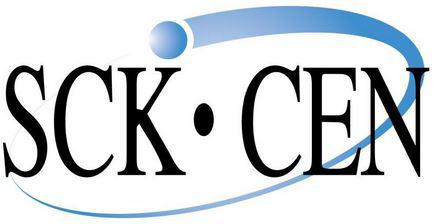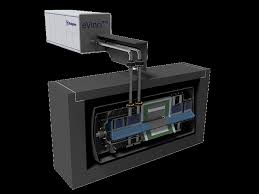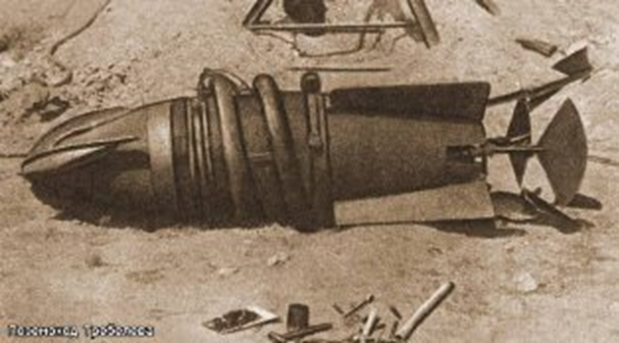Yesterday, I blogged about the search for new radioactive isotopes that might have commercial applications. Belgium is one of five major producers of radioisotopes for medical uses. Annually, almost seven million patients around the globe undergo diagnostic procedures that utilize molybdenum-99 (Mo-99) produced in Belgium.
Mo-99 is produced by bombarding a very pure uranium-235 target with highly energetic neutrons. Mo-99 has a half life of sixty-five hours. It has to be quickly shipped to where it will be used because it decays to technetium-99m which is a metastable isotope of technetium with a half-life of six hours. Metastable means that the nucleus actively emits gamma rays and relaxes into technetium-99 with a half-life of over two hundred thousand years. Te-99m’s short half-life makes Te-99m ideal for injection into patients because it quickly decays into a form which does not emit gamma rays. This minimized overall radiation exposure.
Over a quarter of Belgian medical isotopes are produced at the Nuclear Research Center (SCK-CEN) Belgium Research Reactor Number 2 (BR2) in Mol. These isotopes are subjected to chemical processes by The National Institute for Radioelements (IRE) before they are given to patients. The residue left over from the chemical processing contains various useful elements that can be recovered. These residues are currently being stored in special containers at the IRE’s facility in Fleurus.
The IRE says that the available storage space for these containers of residue will be filled before the end of 2019 if they are unable to move some of the containers to another location. They are taking actions to remedy this such as purchase of additional special containers that will expand storage capacity at the site until 2021.
The RECUMO (Recovery of Uranium from Mo-99 Production) project has been initiated by SCK-CEN and IRE to treat all the residues at the IRE site. The residues will be mixed with low-enriched uranium to dilute them and then purified to produce a low-enriched high-quality material that can then be used. Future residues created by the Mo-99 production process will also be recycled by the RECUMO.
Erich Kollegger is the IRE CEO. He said, “This public-public partnership provides a structural solution for the management of all of the radioactive residues stored at the IRE’s site. It will it make possible to recover those substances for other uses, whilst at the same time ensuring that Belgium retains the expertise that is necessary to ensure the safe management of this nuclear legacy. It also confirms our excellent relationship with SCK-CEN, which we have nurtured for many years now.” Eric van Walle is the Director-General of the SCK-CEN. He said that there would be new advanced infrastructure created in Belgium for the partnership. It will create many long term jobs.
The SCK-CEN and the IRE commented on their partnership today. One of the features of the RECUMO project serves the commitment of Belgium to nuclear nonproliferation. The partnership of the two organizations will be implemented in collaboration with the Directorate-General for Energy of the Federal Public Service Economy, SMEs, Self-Employed and Energy, and under the supervision of Belgium’s Federal Agency for Nuclear Control.
Blog
-

Belgium Production Of Molybdenum-99 Radioisotope
-
Nuclear News Roundup Jan 03, 2019
Perma-Fix Environmental Services, Inc. (NASDAQ: PESI) today provided a business update following its 16th Nuclear Waste Management Forum 2018. Bakersfield.com
Petition To Prevent Ohio River Becoming Nuclear Waste Dump huntingtonnews.net
Kim Jong-un’s North Korea nuke test in 2017 is STILL causing earthquakes today. Dailystar.co.uk
-

Geiger Readings for Jan 03, 2019
Ambient office = 112 nanosieverts per hour
Ambient outside = 126 nanosieverts per hour
Soil exposed to rain water = 128 nanosieverts per hour
Green bell pepper from Central Market = 80 nanosieverts per hour
Tap water = 93 nanosieverts per hour
Filter water = 79 nanosieverts per hour
-

The Search For Unobserved Radioactive Isotopes Continues
Elements are identified by the number of protons in their nucleus. A particular element always has exactly the same number of protons in its nucleus. The nuclear of the atoms of an element also have neutrons. While the number of protons remains the same, there can be samples of the element which have different number of neutrons. These variants of an element are called “isotopes.”
Some isotopes of some elements are stable. Other isotopes of some elements are unstable and are referred to as radioactive. This means that over time, these elemental nuclei will emit the nuclei of helium referred to as alpha particles, energetic electrons referred to as beta particles, energetic photons referred to as gamma rays and/or neutrons as they decay.
The result of these emissions may change one isotope to another or change the element into another element. There are subtle differences between isotopes in terms of how intense their radioactivity may be and how long they take to decay. There is also enormous variation in the amount of each isotope of a particular element that can be found in nature.
There are one hundred and eighteen elements in the periodic table. Most of them occur in nature but some are man-made. Isotopes have many uses today. They are used to create nuclear weapons, carry out medical diagnosis and treatment, take industrial measurements, date organic material to name just a few.
So far, scientists have isolated about three thousand different isotopes of various elements. However, current nuclear theory suggests that about four thousand more isotopes may exist that have not been observed. Around the world, billions of dollars are being spent on research and equipment to find these “missing” isotopes in the hope that some of them may have unique properties that could lead to new technologies.
It can be very difficult to produce rare isotopes. Huge colliders are used that accelerate nuclear particles to near the speed of light and then ram them together. Such collisions can either fuse atoms together to make elements higher on the periodic table or break atoms apart to create new isotopes of simpler elements that may have new and useful properties. Detectors that surround the collision point are used to detect and observe these new nuclei and their properties.
The National Superconducting Cyclotron Laboratory has developed a new highly efficient gamma ray detector called the SuN. Most radioactive isotopes emit gamma rays when they decay. The new SuN detector can catalog properties of isotopes as they appear via analysis of emitted gamma rays. It is very expensive to search for new isotopes even with new devices such as the SuN.
It is impossible to predict exactly what useful properties new isotope will have but considering all the uses that have been found for the three thousand known isotopes, it is probable that some new isotopes will lead to expansion of the current uses of radioactive isotopes and discovery of new uses and future technologies. -

Geiger Readings for Jan 02, 2019
Ambient office = 105 nanosieverts per hour
Ambient outside = 123 nanosieverts per hour
Soil exposed to rain water = 122 nanosieverts per hour
Jalepeno pepper from Central Market = 104 nanosieverts per hour
Tap water = 100 nanosieverts per hour
Filter water = 84 nanosieverts per hour
-

Nuclear Reactors 646 – Westinghouse Working On EVinci Microreactor
Westinghouse has made a lot of money in the international nuclear market for big conventional nuclear power reactors that product a gigawatt or more of electricity. Currently, the nuclear industry is promoting what are called small modular reactors which produce three hundred megawatts or less of electricity. Small, decentralized energy sources have surpassed big power plants in new installation connecting to the national electrical grid.
Westinghouse is jumping on the new trend with something they are calling an “eVinci” microreactor. In June, the Westinghouse eVinci microreactor design got a five-million dollar grant from the U.S. Department of Energy. The new microreactor will be small enough to put on the bed of a truck. The eVinci would act like a nuclear battery. Once installed, it should work for ten years without needed to be refueled.
Westinghouse considered the designs for nuclear reactors used space probes when they designed the eVinci. Arafat said that they are “probably the only nuclear reactor concept that run autonomously, without any operators.” New materials will have to be developed to cope with temperatures up to eleven hundred degrees Fahrenheit. This is almost twice the temperature inside a conventional power reactor.
Yasir Arafat is Westinghouse’s technical lead for eVinci. Last September, Arafat talked about the eVinci design at a microgrid conference at Eaton’s Experience Center. He said the grand vision of Westinghouse was to be able to plug an eVinci microreactor into any microgrid in the world.
Arafat said that the eVinci can recycle nuclear fuel three or four times. The eVinci will be built in a factory and transported by truck or train to the installation site. Arafat claims that it should only take about a week to install an eVinci. Westinghouse says that they anticipate the use of eVinci at remote military bases, remote civilian communities, industrial mines and oil drilling sites. They hope to begin commercial operations in 2024 but have been accused in the past of being overly optimistic in their time and cost estimations.
Rita Baranwal is a former Westinghouse executive who is now heading up the DoE’s nuclear research. She was nominated to be the new assistant secretary for nuclear energy at the DoE. During her Senate confirmation hearing this October, she said that one of her priorities would be to work with the U.S. Department of Defense (DoD) on deploying advanced reactors for military needs.
John Kotek is the vice president of policy development and government affairs at the Nuclear Energy Institute (NEI) which is a nuclear industry lobbying group in Washington, D.C. Kotek said “It’s going to be essential for the federal government to keep providing support (for SMRs).” There are at least six companies working on their own SMRs and looking to the federal government for help.
The DoD has expressed an interest in microreactors. Kotek said that such an interest on the part of the huge federal agency could act as a “demand signal” to stimulate the development of the supply chain that will be required in order for microreactors to be manufactured and deployed. -

Geiger Readings for Jan 01, 2019
Ambient office = 92 nanosieverts per hour
Ambient outside = 116 nanosieverts per hour
Soil exposed to rain water = 114 nanosieverts per hour
New potato from Central Market = 100 nanosieverts per hour
Tap water = 97 nanosieverts per hour
Filter water = 77 nanosieverts per hour
-

Los Alamos National Laboratory Explored The Idea Of A Nuclear Powered Tunneling Machine
When we think about the uses for nuclear power, it is usually in terms of generating heat and electricity for commercial and residential use. Over the years there have been suggestions for using nuclear bombs to excavate canals, create harbors, frack for gas and oil, and create huge caves. None of these applications proved to be practical and were never used. Today, I am going to write about the idea of using nuclear power dig tunnels.
In the 1950s, LANL built a mock-up of a reactor that could heat propellant to about fifty five hundred degrees Fahrenheit. The project was ultimately canceled. One of the engineers who had been working on the project was inspired by the Edgar Rice Boroughs novel At the Earth’s Core to wonder if the tungsten heating element in the abandoned reactor project was hot enough to melt through rock. He carried out experiments which showed that the tungsten heating element could melt through rock by turning it into lava.
One day over lunch, some of the engineers at the LANL discussed the idea of a machine that could melt rock and someone suggested that a nuclear reactor could supply the necessary power. A Congressman was visiting the lab that day and stopped by the table where the discussion was being held. He mistook the idle speculation for a discussion of a potential project and enthusiastically promoted it in Congress. The head of LANL at the time like the idea and so a real project was born.
A research team was assembled and a paper was produced in 1961. It proposed something they called the “nuclear subterrene which would be a vehicle vaguely like a submarine that could melt rock and move through the crust of the Earth like a submarine through water. The design of the vehicle was ultimately patented. The vehicle would be “capable of penetrating the earth to depths of tens of kilometers… To extend geological and geophysical exploration into the earth’s mantle.”
The nuclear subterrene would have no moving parts and would move by melting through the rock instead of cutting. There would be very little vibration which is a major problem with current earth boring machines.
An article that appeared in the Atomic Skies blog said, “Aside from mining, excavating underground roads and pipes was an obvious use. Chemicals and gasses could be stored in underground chambers. Electrical energy could be stored in the form of underground pressurized air ‘batteries,’ compressed in during periods of excess production and used to drive turbines when more energy was needed. The subterrene could dig storage cavities for toxic and nuclear waste, too deep for them to ever trouble the surface. The heat and pressure found deep underground could be exploited for chemical processing. Cities, even farms, could be extended underground.”
In 1972, the National Science Foundation provided funds for a full-scale study of the atomic subterrene to be carried out. A few electrically powered prototype drills were constructed,
and one was used to drill drainage holes at the Bandelier National Monument near Los Alamos. The lack of vibration was very important because there were archeological sites in the Monument that needed to be protected.
There were two different designs for the atomic subterrene. One design included a traditional rotary cutting head that also had cylindrical rock-melters. The other design had no rotary cutting head. Instead, it incorporated nuclear-powered needle probes. The probes were intended to differentially heat the rock ahead of the machine which would cause the rock to crack and crumble. Both of the designs included the idea of converting some of the rock into volcanic glass to line the tunnel. The rest of the rock would be conveyed through a tube at the center of the machine to waiting hoppers in the rear.
In 1975, the project was shifted from the NSF to the Department of Energy where it languished and was ultimately abandoned. In the 1980s, the idea was raised again as a way of digging tunnels on the Moon and other astronomical bodies but never went beyond the conceptual stage. Modern tunnel boring equipment has evolved to the point where it is as good or better than the projected capabilities of the atomic subterrene.
